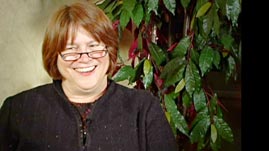Teachers' Domain - Digital Media for the Classroom and Professional Development
User: Preview

Source: Perkins Webcasts: "Writing: The Forgotten Focus for Literacy and Communication Instruction – Linda Hagood"


Educational specialist Linda Hagood describes best practices for teaching writing, and demonstrates classroom interactions with students who are deafblind, in these videos produced jointly by Perkins School for the Blind and the Texas School for the Blind and Visually Impaired.
The Types of Stories to Explore with Students Who Are Blind or Deafblind (Video)
How to Begin the Writing and Storytelling Process (Video)
Strategies to Assist Blind and Deafblind Students to Improve Their Writing Skills (Video)
Linda Hagood notes that children rarely observe adults in the practice of writing, even for practical purposes, and very rarely for storytelling and information. Yet creating narrative can be empowering for children as they learn to express themselves, share their work with others, and gain insights into their classmates’ inner lives by reading the stories they create. Writing has traditionally been a solitary activity, but when approached as a group activity, writing reveals its social currency and challenges students to collaborate and take risks.
This short video collection shows students who are visually impaired and deafblind honing their writing skills, though they are not performing the technical work of writing themselves. Working together, they share story ideas and write collaboratively, exploring “what-if” scenarios and surprising each other with their answers. Educational specialist Hagood describes ways to introduce writing into the curriculum as reflection pieces. By taking writing out of the realm of pencil and paper, teachers of students with visual impairments can open a new communication channel to students.
 Loading Standards
Loading Standards